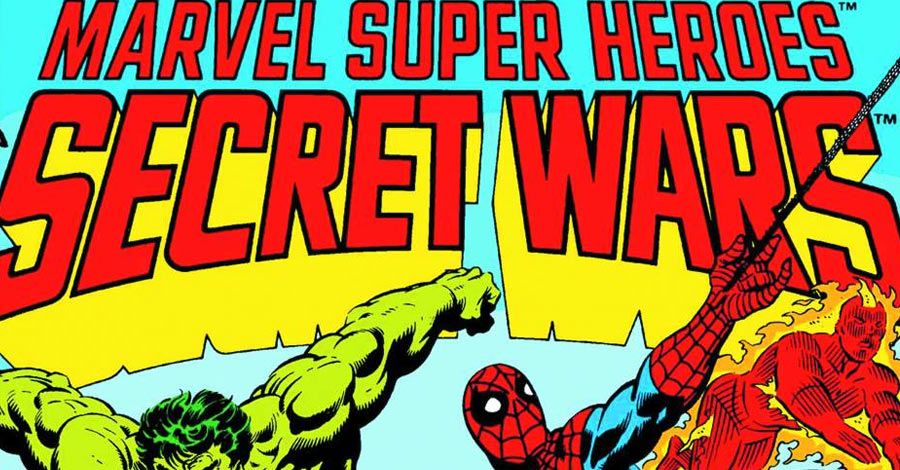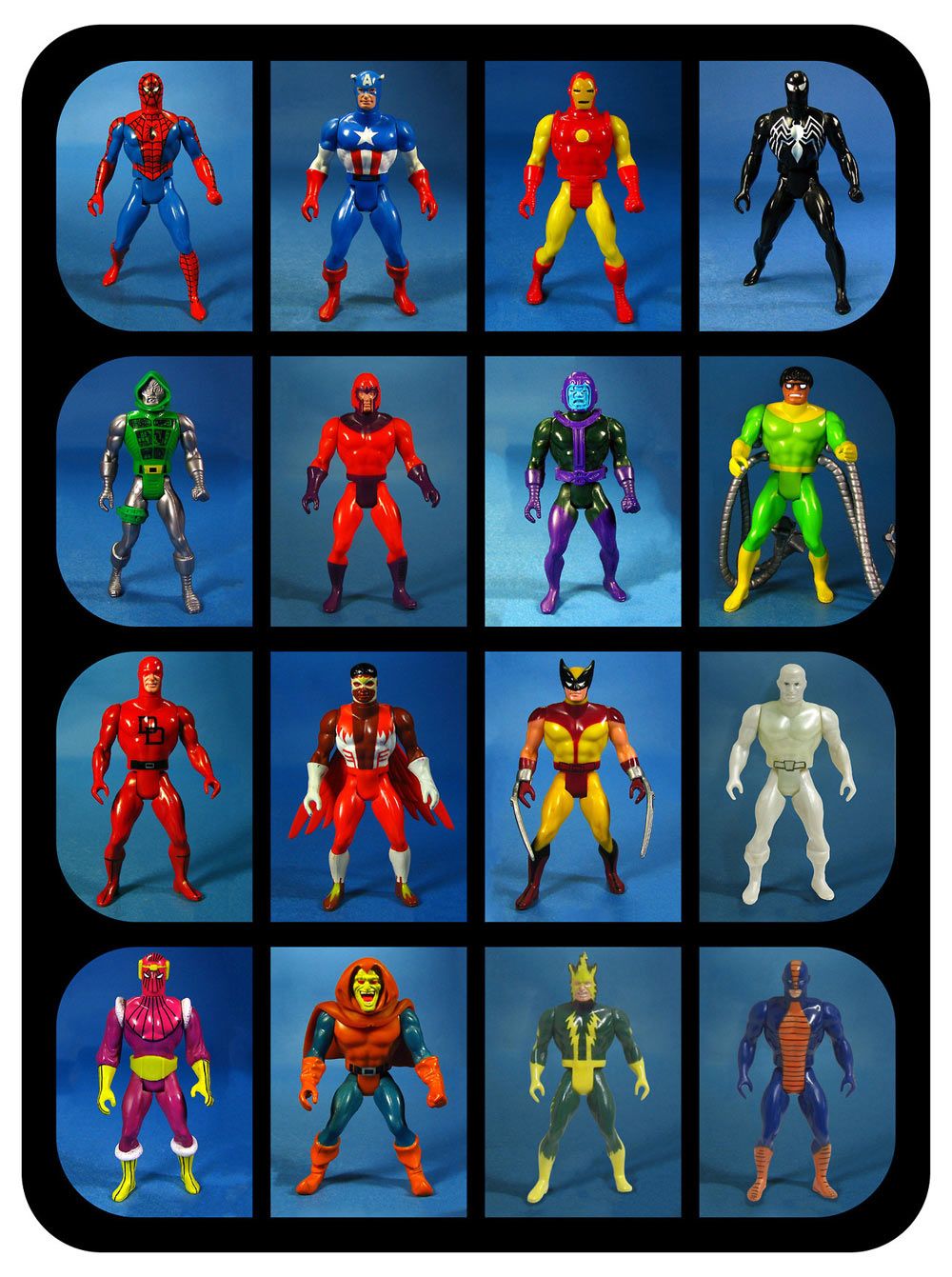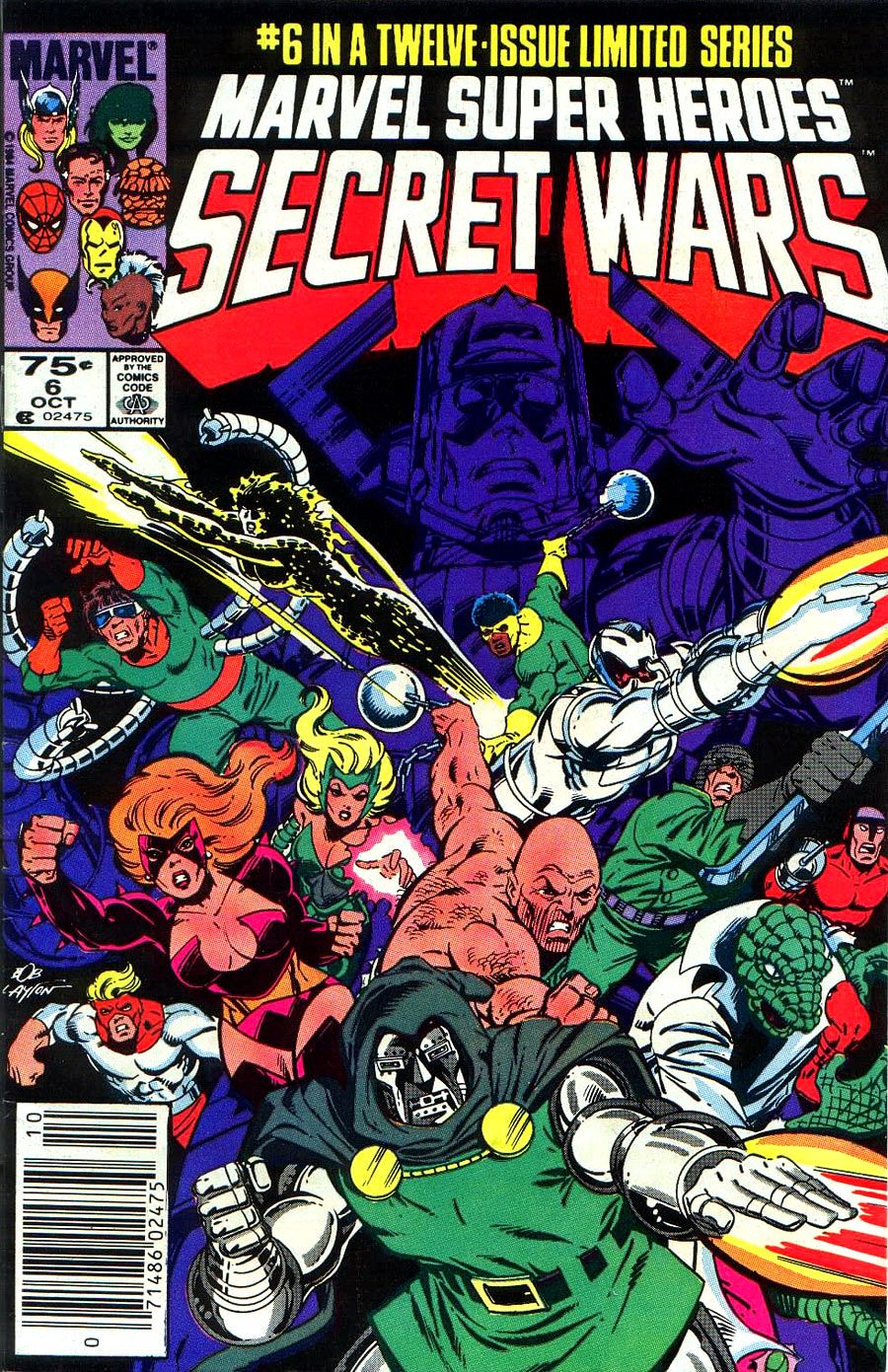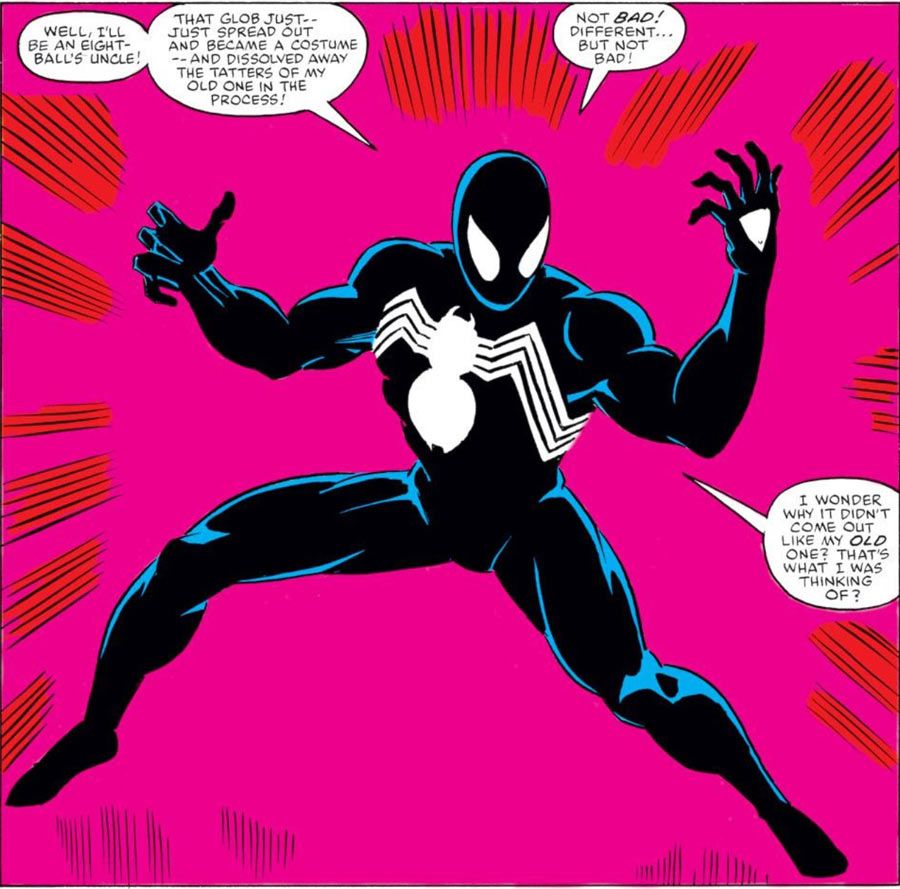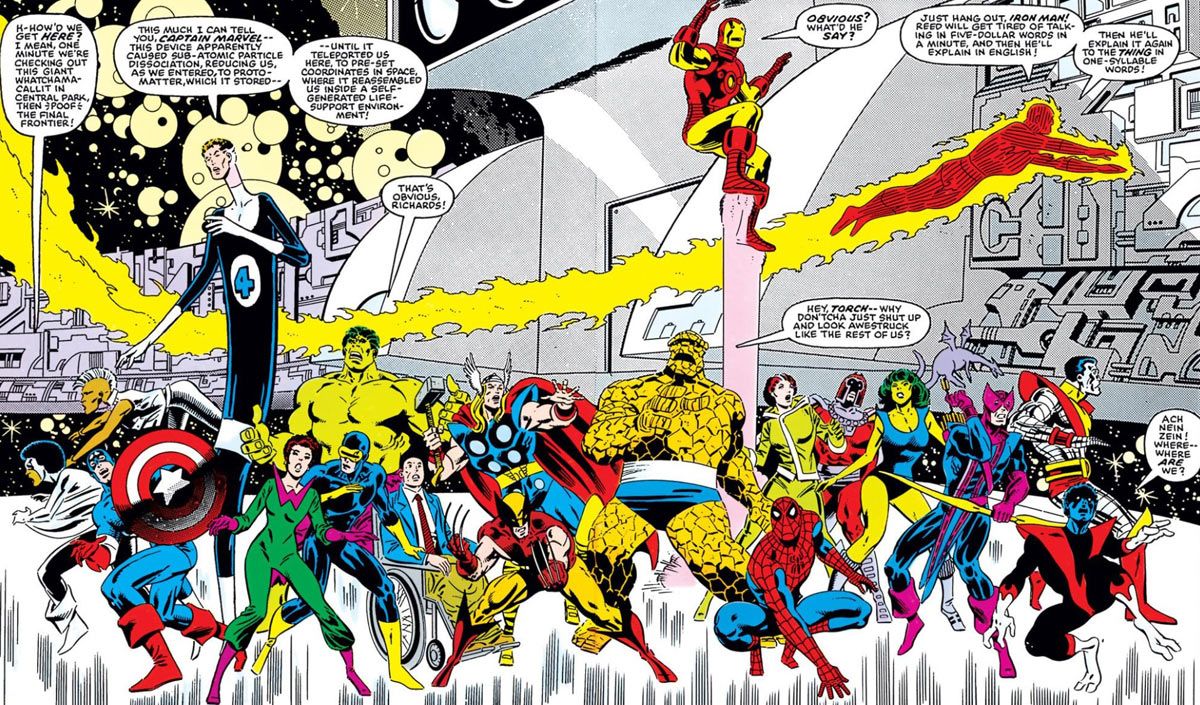In this age of constant event stories, another superhero crossover surprises no one. But when Marvel Comics announces a new "Secret Wars" by Jonathan Hickman and Esad Ribić -- as the publisher did earlier this month during New York Comic Con -- it's something to take note of. The name immediately evokes memories in longtime comic fans of an event -- one of the first true "events" -- that left a lasting narrative and marketing impact on the Marvel Universe. The original "Secret Wars" taught the industry that if a company puts its biggest characters in one series, sales will follow.
"Marvel Super Heroes Secret Wars" was initially published as a way to promote a line of Mattel action figures, but when it was all said and done, it was an event that made an indelible mark on mainstream comics. In 1984, it wasn't unusual to publish comics based on toy lines. "ROM: Spaceknight" was a success for the House of Ideas long after the toy crashed and burned for Parker Brothers, and while the "Micronauts" toy line didn't last long on shelves for Mego, the comic, while never a best seller, attracted an audience thanks to stellar writing by Bill Mantlo and lush artwork by Michael Golden. In 1982, Marvel Comics began publishing "G.I. Joe," and the book was an instant (and enduring) hit, becoming one of the most fondly remembered titles of the era. "Transformers" arrived soon after, followed by lesser toy lines such as "Zoids," "Sectaurs" and even "Madballs."
RELATED: Marvel Announces New "Secret Wars" By Hickman & Ribic in 2015
Yes, "Secret Wars" was another toy-inspired comic, but what made it unique was that the toys in question were based on Marvel's characters. Before Mattel launched its "Secret Wars" line of action figures, comics-based figures had no publishing support. "Secret Wars" was supposed to be a 22-page monthly advertisement for Mattel's new line, but what it became was a model many others would follow. Some people point to "Contest of Champions" as the first true "event" comic, but "Secret Wars" actually had lasting repercussions on the individual characters' solo titles and the Marvel Universe as a whole, a template Marvel, DC Comics and more follow to this day.
The action figures were cool, especially for the mid-80s. About a decade earlier, Mego produced eight-inch dolls, as well as a few 3.75-inch figures that were dubbed "Pocket Heroes." Marvel fans could choose from Spider-Man, Hulk, Captain America and the Green Goblin, but that was pretty much it. When Mattel's "Secret Wars" hit the toy aisle, Marvel fans had a new, massive selection of characters to choose from. Wolverine and Dr. Octopus were shelved alongside Magneto and Kang. Each "Secret Wars" figure came with a shield that could house little hologram cards. One would expect that this may have rendered Captain America not all that special, but it was the '80s, and all toys needed a gimmick.
According to Jim Shooter, Marvel's Editor-in-Chief at the time, in addition to requesting that Dr. Doom and Iron Man have a less medieval look, Mattel wanted a comic that featured one big story with an overarching theme that the toy company could build its line around. The series didn't feature any special shields, but it did introduce a multitude of character beats that went on to impact the heroes and villains in the Marvel Universe. It was also the first standalone series which saw its storylines spill into most of the Marvel titles published at the time, both directly and indirectly. Mattel wanted big, and Shooter provided. "Secret Wars" became something far more than a book that existed to push toys on kids; it was a blueprint for a new way to brand and sell books. Lots and lots of books.
Nowadays, after so many crossover events, fans are used to the concept of their favorite heroes gathering in one place to face a huge threat, but in the 1984, this sort of adventure was a novelty. Yes, Marvel published the "Avengers/Defenders War" in 1973, an event that served as a prototype for many future inter-title crossovers, but there was no core series connected to the event. Marvel also published "Marvel Super Hero Contest of Champions" in 1982, but that storyline -- which was relatively similar to "Secret Wars" -- did not impact any of Marvel's other titles. "Secret Wars" presented a core title that fans could consume as well as crossing over into almost all of Marvel's monthly titles.
Shooter reportedly micromanaged the creators of each of those titles, causing discontent amongst creators who were reluctant to derail their books in order to fit in the E-i-C's pet project. But Shooter was the boss, and"Secret Wars" launched as planned, featuring fantastic art by Mike Zeck and Bob Layton. Fans who wanted the whole story needed to pick up the core series as well as the ongoing titles affected by it. This sales gimmick is familiar to fans now, but in 1984, it was new and innovative, quickly spawning many clones. In fact, DC Comics looked to the "Secret Wars" template for its "Crisis on Infinite Earths," a crossover event that resulted in the entirety of the DC Universe to be rebooted. "Crisis" was much bigger in scope, but it followed the marketing plan and appeal to collectability established by "Secret Wars."
The central plot of "Secret Wars" was wonderful in its simplicity: An alien being named the Beyonder (who was not given form in the first series) kidnaps a large portion of Earth's heroes and villains, forcing them to try and destroy each other. The whole thing is a bit meta, as the heard-but-never-seen Beyonder could be interpreted as a stand in for the audience or a child playing with toys, an unseen force eager to watch the colorful heroes and villains fight each other. The Beyonder's Battleworld was constructed from pieces of many worlds, and stocked with alien weapons and technology for the heroes and villains to use.
The heroes called to Battleworld were Captain America, Captain Marvel (Monica Rambeau), Hawkeye, Iron Man (James Rhodes), She-Hulk, Thor, the Wasp, The Human Torch, Mister Fantastic, The Thing, Spider-Man and the Hulk. Their villainous counterparts included Absorbing Man, Doctor Doom, Doctor Octopus, the Enchantress, Kang the Conqueror, Klaw, the Lizard, Molecule Man, Titania, Ultron and the Wrecking Crew. But the story didn't play out as a mere good versus evil clash as the social landscape of Battleworld quickly mirrored that of Earth. The Beyonder also summoned members of the X-Men (Colossus, Cyclops, Nightcrawler, Professor X, Rogue, Storm, Wolverine and Lockheed), who quickly isolated themselves from the other heroes, forming a third faction and carrying the themes of marginalization and segregation over from the pages of "Uncanny X-Men." The X-Men served as a fascinating wild card, particularly Magneto, who had recently made a heroic turn in the pages of the X-books. When the Avengers and the other heroes questioned Magneto's presence, he grew angry and removed himself from the proceedings, essentially forming a fourth, solo faction. And standing above these mutants, traditional heroes and villains was none other than Galactus.
RELATED: Alex Ross Dives Deep Into Marvel's "Secret Wars"
Shooter quickly established the Beyonder as the biggest cosmic threat the Marvel Universe had ever seen. Galactus and Dr. Doom both attack the Beyonder and were quickly (and some might say unrealistically) swatted away. The evil android Ultron tried to go up against Galactus and lost -- badly. Ultron's actions established a sense of disunity amongst the villains, something that would continue throughout the event.
As we mentioned earlier, while it was created as a toy tie-in, "Secret Wars" actually had a very real and noticeable effect on much of the broader Marvel Universe. The biggest change was originally a cosmetic one, but it garnered mainstream attention and kicked off dozens and dozens of stories. One of the machines the Beyonder designed and placed on Battleword was some kind of replicator device that the heroes used to replace their torn costumes. After his familiar red and blue garment was torn in battle, Peter Parker used the device to create new one. Apparently subconsciously inspired by the black suit of a new Spider-Woman (we'll get to her in a moment), Spidey ended up with a new, black suit, one that that has become iconic in its own right. But the old Parker luck was true to form as Peter actually used the wrong machine. Instead of cloth, the costume was in fact a sentient blob of black goo. This new, alien suit led to a lengthy storyline finding Spidey becoming more aggressive as the symbiote attempted to take control of Peter, eventually leading to the introduction of iconic Spider-foe Venom, a villain who became one of the most important and widely recognized aspects of Spider-Man's world.
Back to Spider-Woman: As we said, the Beyonder constructed Battleworld from pieces of many planets, including part of Denver, Colorado. Julia Carpenter was a resident of the abducted city, and found herself embroiled in the events of the epic battle, eventually becoming the new Spider-Woman. She had instant impact on Marvel, becoming one of the first single mother superheroes in comics and soon joining the Avengers. Carpenter is still around today, having become the second Madame Web and playing an important if enigmatic role in Dan Slott's current run on "Amazing Spider-Man."
The second Spider-Woman was not the only new character introduced in "Secret Wars." Doctor Doom experimented on two women, granting them powers and making them both a powerful force that could have turned the tide in the conflict on Battleworld. The first woman to receive Doom's "gifts" became the villainous powerhouse Titania, who eventually joined the Masters of Evil as well as becoming a major adversary for She-Hulk. Titania ended up becoming romantically linked to "Crusher" Creel, the Absorbing Man and an interesting force in the villainous landscape of the Marvel Universe.
Victor Von Doom's second creation was Volcana. While not having as much of a historical impact as Titania or Spider-Woman, Volcana did change the story direction of a long-time tragic villain, the Molecule Man. A lonely, pathetic soul gifted with the power of the cosmos, upon meeting Volcana, Molecule Man quickly found his romantic other. He was no longer alone, and had a different, more confident approach to life.
The event also featured a temporary power upgrade for Dr. Doom, who stole the Beyonder's might during the final chapters. By having Doom stand out among the villains that went to Battleworld, Shooter further established Doom as the Marvel Universe's premier villain. Other antagonists were soldiers when compared to Doom, who dared to challenge the godlike Beyonder.
In addition to enhancing Doom's status, the series went a long way to establish Magneto as the ultimate loner. As we mentioned, in the pages of "Uncanny X-Men" and "New Mutants" Magneto had reformed and become a part of Xavier's School. The non-mutant heroes of the Marvel Universe's rejection of Magneto's attempts at altruism further isolated the once-master villain and planted seeds of doubt in his mind -- doubts that would play a huge part in the story of Magneto moving forward.
Villains weren't the only characters impacted, as "Secret Wars" led to major changes in status quo for two of Marvel's greatest powerhouses, the Thing and Colossus. After the Beyonder's war was over, the Thing, who somehow gained the ability to turn into his human form of Ben Grimm during the course of the series, decided to stay on Battleworld, a decision that fueled almost a year's worth of stories in his solo title, while forcing major changes in the Fantastic Four.
In the wake of Grimm's departure, She-Hulk joined Marvel's famous foursome, resulting in an exciting new dynamic for that title. And the seismic changes to the FF didn't end there: When the Thing returned from Battleworld, he found his long-time love Alicia Masters in the arms of Johnny Storm, the Human Torch. This soap opera element created a nearly unbreakable wedge between Ben and Johnny, the latter of which later married Masters. (This Alicia was eventually revealed to be a Skrull, but that's a story for another time.)
Meanwhile, the X-Men's Colossus was so affected by his experiences on Battleworld that he ended his relationship with fellow X-Man Kitty Pryde. This event took both characters in new directions, as fans saw an end to one of the longest-standing romances in the Marvel Universe.
All of these character beats were important to the overall tapestry of the Marvel Universe, but it was in marketing where "Secret Wars" biggest impact was felt. The major comic companies and retailers now knew the power of branding. Fans everywhere had experienced a comic storyline in a way that they never had before, and if sales were any indication, they liked it.
"Secret Wars II" was published soon after the first series ended, and while it found sales success, most critics and fans panned it. The Beyonder was no longer a mysterious cosmic force but an actual flesh and blood character complete with perm and disco outfit, and the more blatant tie-ins with various Marvel titles had mixed results at best, but the notion of the crossover event was now an indelible part of the comic book landscape.
By the time the "Secret Wars" toys were on clearance at toy stores, the comic book market had been forever altered. As we head towards the new "Secret Wars," it's important to remember what the initial event meant to the industry, the direct market and the characters of the Marvel Universe.

